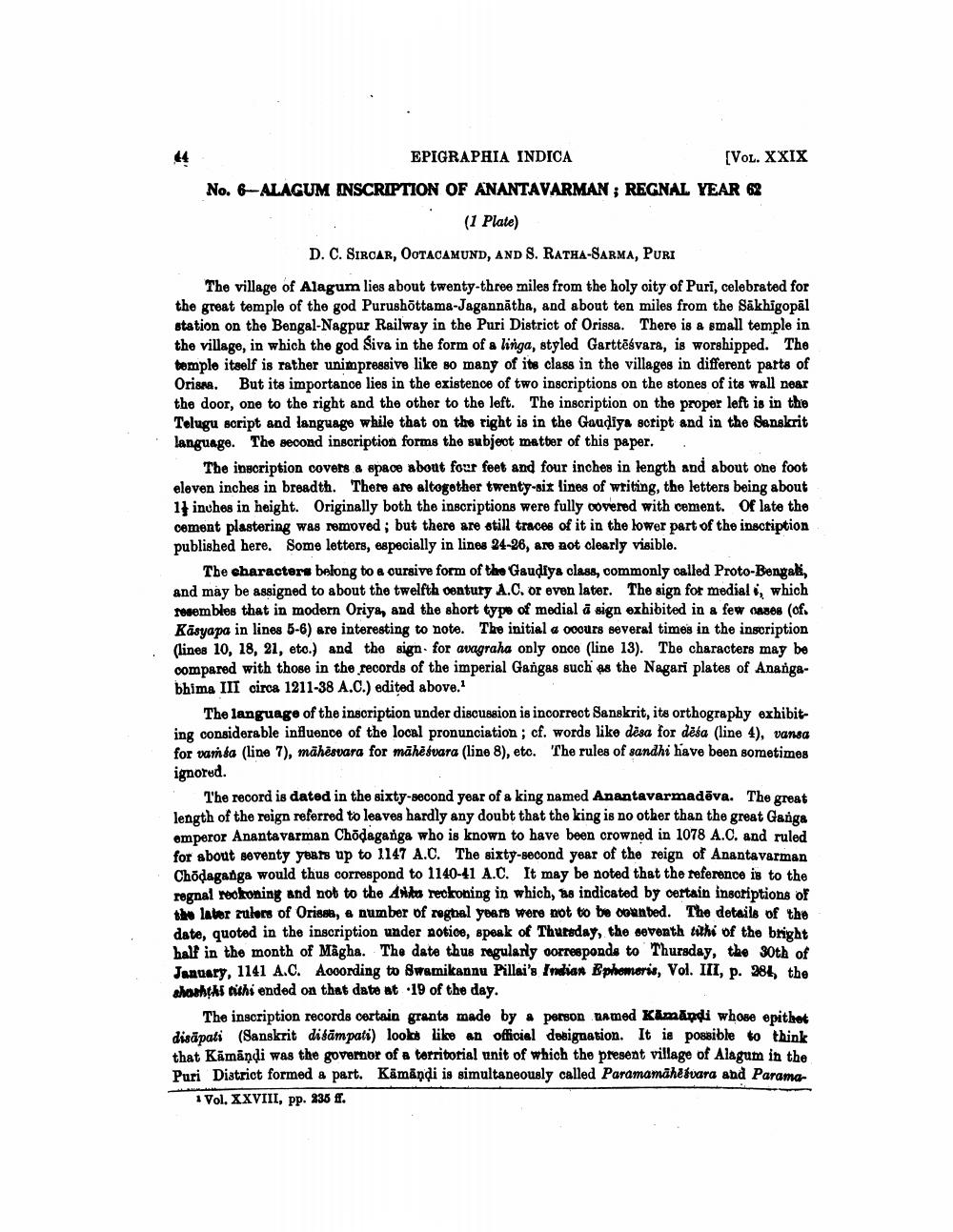________________
EPIGRAPHIA INDICA
[VOL. XXIX
No. 6-ALAGUM INSCRIPTION OF ANANTAVARMAN; REGNAL YEAR 62
(1 Plate)
D. C. SIRCAR, OOTACAMUND, AND S. RATHA-SARMA, PURI
The village of Alagum lies about twenty-three miles from the holy city of Puri, celebrated for the great temple of the god Purushottama-Jagannatha, and about ten miles from the Sākhigopāl station on the Bengal-Nagpur Railway in the Puri District of Orissa. There is a small temple in the village, in which the god Siva in the form of a linga, styled Garttēśvara, is worshipped. The temple itself is rather unimpressive like so many of its class in the villages in different parts of Orissa. But its importance lies in the existence of two inscriptions on the stones of its wall near the door, one to the right and the other to the left. The inscription on the proper left is in the Telugu script and language while that on the right is in the Gaudiya script and in the Sanskrit language. The second inscription forms the subject matter of this paper.
"
The inscription covers a space about four feet and four inches in length and about one foot eleven inches in breadth. There are altogether twenty-six lines of writing, the letters being about 1 inches in height. Originally both the inscriptions were fully covered with cement. Of late the cement plastering was removed; but there are still traces of it in the lower part of the inscription published here. Some letters, especially in lines 24-26, are not clearly visible.
The characters belong to a cursive form of the Gaudiya class, commonly called Proto-Bengali, and may be assigned to about the twelfth century A.C. or even later. The sign for mediali, which resembles that in modern Oriya, and the short type of medial a sign exhibited in a few cases (of. Kasyapa in lines 5-6) are interesting to note. The initial a occurs several times in the inscription (lines 10, 18, 21, etc.) and the sign for avagraha only once (line 13). The characters may be compared with those in the records of the imperial Gangas such as the Nagari plates of Anangabhima III circa 1211-38 A.C.) edited above.1
The language of the inscription under discussion is incorrect Sanskrit, its orthography exhibiting considerable influence of the local pronunciation; cf. words like desa for desa (line 4), vansa for vaméa (line 7), māhēsvara for māheśvara (line 8), etc. The rules of sandhi have been sometimes ignored.
The record is dated in the sixty-second year of a king named Anantavarmadeva. The great length of the reign referred to leaves hardly any doubt that the king is no other than the great Ganga emperor Anantavarman Chōdaganga who is known to have been crowned in 1078 A.C. and ruled for about seventy years up to 1147 A.C. The sixty-second year of the reign of Anantavarman Chodaganga would thus correspond to 1140-41 A.C. It may be noted that the reference is to the regnal reckoning and not to the Anta reckoning in which, as indicated by certain inscriptions of the later rulers of Orissa, a number of regnal years were not to be counted. The details of the date, quoted in the inscription under notice, speak of Thursday, the seventh tithi of the bright half in the month of Magha. The date thus regularly corresponds to Thursday, the 30th of January, 1141 A.C. According to Swamikannu Pillai's Indian Ephemeris, Vol. III, p. 284, the shashthi tithi ended on that date at 19 of the day.
The inscription records certain grants made by a person named Kämandi whose epithet disapati (Sanskrit disampati) looks like an official designation. It is possible to think that Kāmāṇḍi was the governor of a territorial unit of which the present village of Alagum in the Puri District formed a part. Kämäṇḍi is simultaneously called Paramamahětvara and Parama1 Vol. XXVIII, pp. 235 ff.




